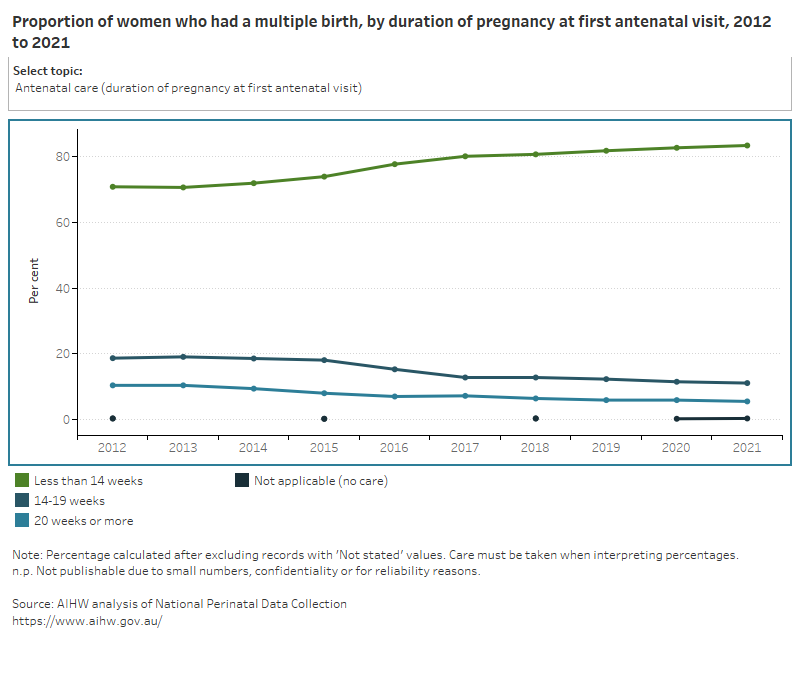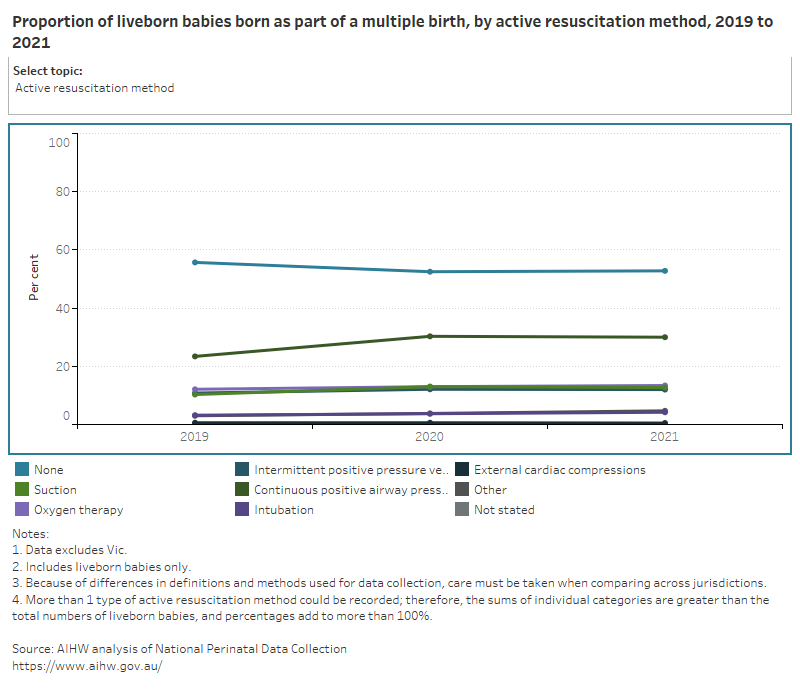Mothers who have multiple births and their babies
Multiple births are births of more than one baby from a single pregnancy, and include twins, triplets and higher order multiples. This section focuses on mothers who had a multiple birth and babies born as part of a multiple birth.
While considered higher risk, most multiple pregnancies have positive outcomes for mothers and babies. However, women who have multiple births, and their babies, are at increased risk of certain conditions, including preeclampsia, anaemia, gestational diabetes, post-partum haemorrhage, pre-term birth, low birthweight, twin–twin transfusion syndrome and developmental delay. Families with multiple births may also experience financial stress, social isolation, and difficulties in accessing appropriate education (TRA 2019).
Additional care for families who have twins or other multiples is essential to eliminate or manage complications associated with multiple pregnancies. Appropriate support is important from early pregnancy through to the early years of the babies’ lives, including frequent antenatal care visits, access to specialist obstetric and paediatric care and access to services to support child development (TRA 2019).
The number of multiple births in Australia each year is small and has remained relatively stable at around 2-3% of all births (from 3.1% (9,288) of births in 2011 to 2.7% (8,625) of births in 2021).
In 2021, of this small proportion, almost all multiple births (98%) were twins, while the remaining 2% were other multiples (that is, triplets, quadruplets or higher).
Mothers who had a multiple birth
In 2021, mothers who had a multiple pregnancy accounted for 1.4% (4,218) of all women who gave birth.
Figure 1 presents data for women who had a multiple birth gave birth, by selected maternal characteristics over an 11-year period (where available).
Figure 1: Proportion of women who had a multiple birth, by selected topic
Line graph of proportion of women who had a multiple birth by selected topics between 2011 and 2021.

Most mothers of multiples attended an antenatal visit in the first trimester (84%) and had 5 or more antenatal visits (96%).
Over half of mothers had no labour, and this proportion has increased over time (50% in 2011 compared with 58% in 2021). Mothers of multiples therefore had a high rate of caesarean sections (75%).
For more information on mother who had a multiple birth see National Perinatal Data Collection annual update data table 2.24.
Babies born as part of a multiple birth
In 2021, babies born as part of a multiple pregnancy accounted for 2.7% (8,625) of all births.
Figure 2 presents data for babies born as part of a multiple birth, by selected baby characteristics over an 11-year period (where available).
Figure 2: Proportion of liveborn babies born as part of a multiple birth, by selected topic
Line graph of babies born as part of a multiple birth by selected topics between 2019 and 2021.

Most babies from multiple births had an Apgar score of 7–10 at 5 minutes (95%), indicating that they have adapted well post-birth. More than half of babies in multiple births were born low birthweight (54%) or pre-term (66%), including babies who were both low birthweight and pre-term. As a result, 65% of multiple births were admitted to SCN or NICU, and 45% had hospital stays of 6 days or more.
References
TRA (Twins Research Australia) (2019) Multiple perspectives: what support do multiple birth families need to live happy and healthy lives, TRA, The University of Melbourne, Melbourne, accessed 21 June 2022.


